The year 1930 in architecture involved some significant events.
The year 1928 in architecture involved some significant architectural events and new buildings.
The year 1918 in architecture involved some significant architectural events and new buildings.

Skogskyrkogården is a cemetery located in the Gamla Enskede district south of central Stockholm, Sweden. Its design, by Gunnar Asplund and Sigurd Lewerentz, reflects the development of architecture from Nordic Classicism to mature functionalism.

Erik Gunnar Asplund was a Swedish architect, mostly known as a key representative of Nordic Classicism of the 1920s, and during the last decade of his life as a major proponent of the modernist style which made its breakthrough in Sweden at the Stockholm International Exhibition (1930). Asplund was professor of architecture at the Royal Institute of Technology from 1931. His appointment was marked by a lecture, later published under the title "Our architectonic concept of space." The Woodland Crematorium at Stockholm South Cemetery (1935-1940) is considered his finest work and one of the masterpieces of modern architecture.

Stockholm Public Library is a library building in Stockholm, Sweden, designed by Swedish architect Gunnar Asplund, and one of the city's most notable structures. The name is today used for both the main library itself as well as the municipal library system of Stockholm.

Ivar Justus Tengbom was a Swedish architect and one of the best-known representatives of the Swedish neo-classical architecture of the 1910s and 1920s.

Ralph Erskine ARIBA was a British architect and planner who lived and worked in Sweden for most of his life.
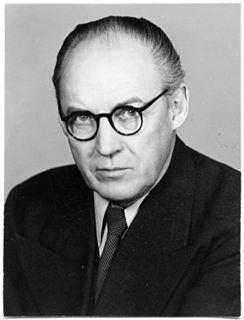
Sigurd Lewerentz was a Swedish architect.

Carl Nyrén was a Swedish architect.
This article covers the architecture of Sweden from a historical perspective.
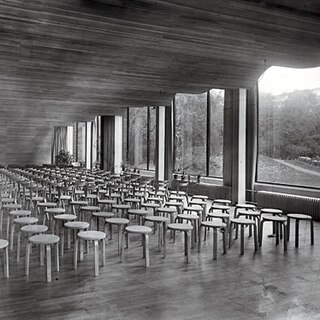
Vyborg Library is a library in Vyborg, Russia, built during the time of Finnish sovereignty, before the Finnish city of Viipuri was annexed by the former USSR and its Finnish name was changed to Vyborg by the Soviet authorities.

Nordic Classicism was a style of architecture that briefly blossomed in the Nordic countries between 1910 and 1930.
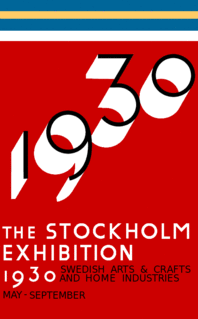
The Stockholm Exhibition was an exhibition held in 1930 in Stockholm, Sweden, that had a great impact on the architectural styles known as Functionalism and International Style.
Asplund is a Swedish surname. Notable people with the surname include:

Jonathan Woolf was a British architect.
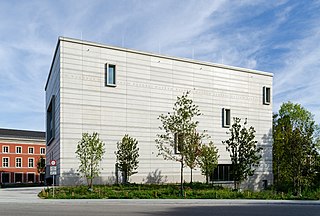
The Bauhaus Museum Weimar is a museum dedicated to the Bauhaus design movement located in Weimar, Germany. It presents the Weimar collections of the State Bauhaus, which was founded in the town in 1919. The museum is a project of the Klassik Stiftung Weimar and is located near the Weimarhallenpark. Originally opened in 1995, it is now housed in a new building since April 2019.
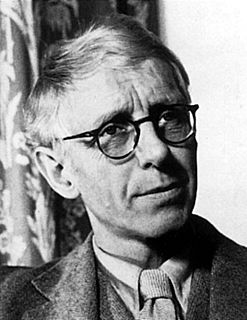
Carl Malmsten was a Swedish furniture designer, architect, and educator who was known for his devotion to traditional Swedish craftmanship (slöjd) and his opposition to functionalism. He "considered the rationalization of the home according to functionalist principles a debasement of its traditional role as an intimate place for gathering and repose".
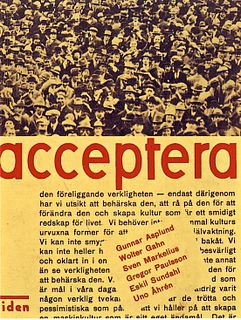
acceptera (1931) is a Swedish modern architecture manifesto written by architects Gunnar Asplund, Wolter Gahn, Sven Markelius, Eskil Sundahl, Uno Åhrén, and art historian Gregor Paulsson. Claiming that Swedish “building-art” (byggnadskonst) has failed to keep pace with the revolutionary social and technological change sweeping Europe in the early 20th century, the authors argue that the production of housing and consumer goods must embrace a functionalist orientation in order to meet the particular cultural and material needs of both modern society and the modern individual. Combining social analysis with an iconoclastic critique of contemporary architecture and handicraft, acceptera ardently calls upon its readers not to shrink back from modernity, but rather to “accept the reality that exists—only in that way have we any prospect of mastering it, taking it in hand, and altering it to create a culture that offers an adaptable tool for life.”

Villa Sturegården is arguably the first completed project (1913) by architect Gunnar Asplund. It is a residential house located in the city of Nyköping, some 100 km south of Stockholm, Sweden.














